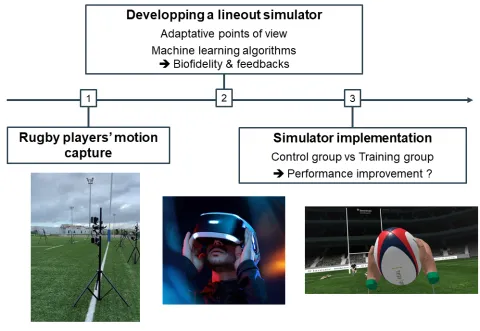Summary
This doctoral project, untitled RUGLIFT, aims to develop a virtual environment simulator to optimize the performance of players involved in the rugby lineout phase. Our first objective is to capture the movements of all players involved in the lineout sequence. The capture will be carried out using an optoelectronic system and a video camera system (Qualisys). These data will be used to reconstruct the players' skeletons in 3D from the video data, using Theia markerless algorithms (Theia3D). This data will be used to:
1. analyze collective spatio-temporal lineout coordination,
2. develop a lineout training simulator by generating lineout situations in virtual environments from players' movement data,
3. feed automatic learning algorithms that will be used to generate new touch situations in virtual environments to increase the variability of situations.
Objective
This project aims to develop a tool based on virtual environments and intelligent systems to optimize the performance of players involved in rugby lineout.
In the first stage, player movements will be recorded during game situations using markerless multi-camera motion capture tools (Miqus video, Qualisys and Theia Markerless sofware). The main game configurations during lineout will be identified and standardized, in agreement with rugby clubs performance units. This first stage will enable an in-depth analysis of the players' biomechanics involved, depending on their position (thrower, line of forwards, line of defenders), as well as the collective spatio-temporal coordinations associated with performance factors during lineout.
In a second phase, a lineout simulator will be developed and evaluated for each player involved, according to their position. The above data will be used to generate lineout situations in a virtual environment, in which the virtual players will be endowed with a layer of behavioral autonomy specific to their position. This will be derived from previous analyses, as well as from machine learning algorithms designed to increase the variability of the situations proposed by artificially generating new configurations from the situations captured (Barambones et al., 2022). To validate the credibility of the situations subsequently generated, they will be presented to expert players through a virtual reality headset adopting an ecological point of view, in order to study the consistency of their movements in the simulation compared with those observed in real sport situations. Each position will be addressed by the simulator. A particular attention will be given to the interaction of the thrower with the (real) ball, which trajectory will be recorded by a video camera during the throw, and reproduced in real time into the simulator. Various feedbacks will be tested to assist the thrower (isolated work on synchronization, distance, angle), making it possible to control factors determining performance. In addition, for both the attack and defense lines, the simulator will need to handle the immersion of several real players in a hybrid environment populated by virtual agents.
The final stage of this doctoral project aims to determine whether simulator training improves players' lineout performance, depending on their initial level and position. Rugby players will be tested before and after a training program based on the simulator. Their performance will be compared to a control group who did not use the simulator. The aim is also to identify aspects of the simulator that could be improved for greater efficiency, such as immersion, realism of interactions, and environmental conditions.

Global approach of the RUGLIFT project

